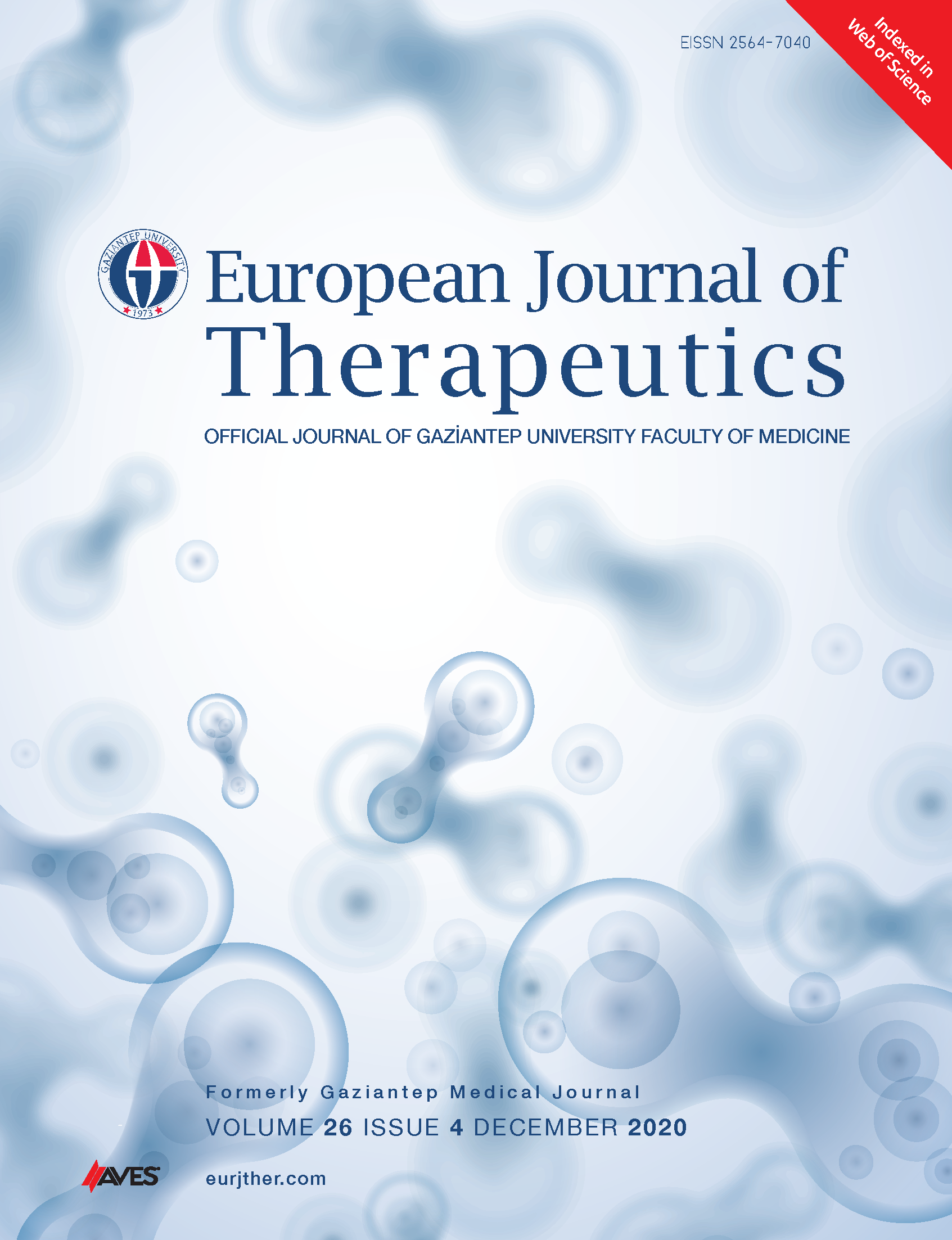Comparison of CRP, Full Blood Count Parameters and Transaminases across Different Age Groups of Children with Mycoplasma Pneumonia
DOI:
https://doi.org/10.5152/eurjther.2020.20068Keywords:
Mycoplasma pneumonia, CRP, children, full blood countAbstract
Objective: Mycoplasma pneumonia (MP) is a common cause of community-acquired pneumonia in about 10%–30% of children. The combination of polymerase chain reaction (PCR) with serology tests appears to provide better accuracy in the diagnosis of MP; however, these tests are not widely available. Therefore, its diagnosis could be challenging in younger children and would still require other conventional approaches with clinical examination, chest X-ray, and basic laboratory tests such as full blood count and c-reactive protein (CRP) across the most of the clinical settings. In this regard, the objective of this study is to investigate how CRP, full blood count parameters, and transaminases differ among older and younger children.
Methods: We reviewed the data of 2,246 patients aged between 0 and 18 years who were diagnosed with pneumonia between January 2011 and December 2018, and finally included 49 patients who had positive MP IgM in this study. Thereafter, we divided the patients into two groups as children aged ≤5 years and children aged >5 years, and compared the values of hemoglobin, white blood cell (WBC), neutrophils, lymphocytes, eosinophils, monocytes, platelet, CRP, and transaminases in the groups.
Results: The analyses showed that WBC (p=0.001), lymphocytes (p=0.001) and monocyte counts (p=0.004), and CRP (p=0.013) were significantly higher in the children younger than five years. On the contrary, Hb was significantly lower in the children younger than five years (p=0.001).
Conclusion: Children younger than five years who have been diagnosed with MP might exhibit more inflammatory response, which is represented with higher CRP levels. Although monocyte and lymphocyte counts were also higher in the younger group (less than five years), this might be an age-related finding.
Metrics
References
Michelow IC, Olsen K, Lozano J, Rollins NK, Duffy LB, Ziegler T, et al. Epidemiology and clinical characteristics of community-acquired pneumonia in hospitalized children. Pediatrics 2004; 113: 701-7.
Chiang WC, Teoh OH, Chong CY, Goh A, Tang JP, Chay OM. Epidemiology, clinical characteristics and antimicrobial resistance patterns of community-acquired pneumonia in 1702 hospitalized children in Singapore. Respirology 2007; 12: 254-61.
Sillis M. The limitations of IgM assays in the serological diagnosis of Mycoplasma pneumoniae infections. J Med Microbiol 1990; 33: 253-8.
Daxboeck F, Krause R, Wenisch C. Laboratory diagnosis of Mycoplasma pneumoniae infection. Clin Microbiol Infect 2003; 9: 263-73.
Chang HY, Chang LY, Shao PL, Lee PI, Chen JM, Lee CY, et al. Comparison of real-time polymerase chain reaction and serological tests for the confirmation of Mycoplasma pneumoniae infection in children with clinical diagnosis of atypical pneumonia. J Microbiol Immunol Infect 2014; 47: 137-44.
Krafft C, Christy C. Mycoplasma Pneumonia in Children and Adolescents. Pediatr Rev 2020; 41: 12-9.
Gao LW, Yin J, Hu YH, Liu XY, Feng XL, He JX, et al. The epidemiology of paediatric Mycoplasma pneumoniae pneumonia in North China: 2006 to 2016. Epidemiol Infect 2019; 147: e192.
He XY, Wang XB, Zhang R, Yuan ZJ, Tan JJ, Peng B, et al. Investigation of Mycoplasma pneumoniae infection in pediatric population from 12,025 cases with respiratory infection. Diagn Microbiol Infect Dis 2013; 75: 22-7.
Waites KB, Xiao L, Liu Y, Balish MF, Atkinson TP. Mycoplasma pneumoniae from the Respiratory Tract and Beyond. Clin Microbiol Rev 2017; 30: 747-809.
Ma YJ, Wang SM, Cho YH, Shen CF, Liu CC, Chi H, et al. Clinical and epidemiological characteristics in children with community-acquired mycoplasma pneumonia in Taiwan: A nationwide surveillance. J Microbiol Immunol Infect 2015; 48: 632-8.
Lu Y, Wang Y, Hao C, Ji W, Chen Z, Jiang W, et al. Clinical characteristics of pneumonia caused by Mycoplasma pneumoniae in children of different ages. Int J Clin Exp Pathol 2018; 11: 855-61.
Defilippi A, Silvestri M, Tacchella A, Giacchino R, Melioli G, Di Marco E, et al. Epidemiology and clinical features of Mycoplasma pneumoniae infection in children. Respir Med 2008; 102: 1762-8.
Lugada ES, Mermin J, Kaharuza F, Ulvestad E, Were W, Langeland N, et al. Population-based hematologic and immunologic reference values for a healthy Ugandan population. Clin Diagn Lab Immunol 2004; 11: 29-34.
Shearer WT, Rosenblatt HM, Gelman RS, Oyomopito R, Plaeger S, Stiehm ER, et al. Lymphocyte subsets in healthy children from birth through 18 years of age: the Pediatric AIDS Clinical Trials Group P1009 study. J Allergy Clin Immunol 2003; 112: 973-80.
Onozuka D, Hashizume M, Hagihara A. Impact of weather factors on Mycoplasma pneumoniae pneumonia. Thorax 2009; 64: 507-11.
Kim KW, Sung JJ, Tchah H, Ryoo E, Cho HK, Sun YH, et al. Hepatitis associated with Mycoplasma pneumoniae infection in Korean children: a prospective study. Korean J Pediatr 2015; 58: 211-7.
Wang L, Feng Z, Shuai J, Liu J, Li G. Risk factors of 90-day rehospitalization following discharge of pediatric patients hospitalized with mycoplasma Pneumoniae pneumonia. BMC Infect Dis 2019; 19: 966.
Williams DJ, Hall M, Brogan TV, Farris RW, Myers AL, Newland JG, et al. Influenza coinfection and outcomes in children with complicated pneumonia. Arch Pediatr Adolesc Med 2011; 165: 506-12.
Downloads
Published
How to Cite
Issue
Section
License
Copyright (c) 2023 European Journal of Therapeutics

This work is licensed under a Creative Commons Attribution-NonCommercial 4.0 International License.
The content of this journal is licensed under a Creative Commons Attribution-NonCommercial 4.0 International License.


















